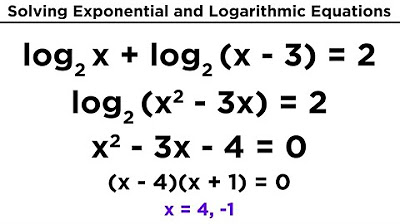Solving Logarithmic Inequalities | General Mathematics
Summary
TLDRIn this instructional video, the presenter discusses techniques for solving logarithmic inequalities, paralleling methods used in solving logarithmic equations. Key examples illustrate how to convert logarithmic expressions to exponential form, isolate variables, and apply properties such as the power rule. The video emphasizes the importance of understanding domain restrictions in logarithmic functions. Through step-by-step explanations, viewers learn to tackle various inequalities involving logarithmic functions with different bases, ultimately guiding them to find the correct solutions.
Takeaways
- 📚 Logarithmic inequalities are solved using similar techniques as logarithmic equations, focusing on the positivity of arguments.
- 🔍 Always check the domain of the logarithmic expressions to ensure that the arguments are greater than zero.
- 💡 To solve inequalities, convert them to exponential form to simplify the process.
- 🔗 Example 1 shows how to solve the inequality \(\log_2(2x + 1) < 3\) leading to the final solution \(-\frac{1}{2} < x < \frac{7}{2}\).
- ⚖️ In Example 2, transforming \(\log_4(9) > 2 \log_4(x)\) simplifies to the inequality \(9 > x^2\), resulting in \(0 < x < 3\).
- 📊 Example 3 illustrates combining logarithms: \(\log_3(x) + \log_3(6) \geq 2\) leads to the solution \(x \geq \frac{3}{2}\).
- 🔄 In Example 4, manipulating \(\log_3(x) - 3\log_3(2) \leq 1\) results in the inequality \(0 < x \leq 24\).
- ⚡ Utilizing properties of logarithms, such as the product and power rules, is essential for simplifying expressions.
- 📝 It is crucial to keep track of the steps taken during the problem-solving process to avoid mistakes.
- 🤝 Viewers are encouraged to ask questions or seek clarification in the comments for better understanding.
Q & A
What is the primary focus of the video?
-The video focuses on solving logarithmic inequalities, explaining the techniques and strategies used to solve such inequalities step by step.
How are logarithmic inequalities similar to logarithmic equations?
-Logarithmic inequalities are solved in much the same way as logarithmic equations, with the primary difference being the inequality signs and the need to consider the domain restrictions.
Why is it important to consider the domain restrictions in logarithmic inequalities?
-Domain restrictions are important because the arguments of logarithmic expressions must be positive. This ensures that the logarithmic function is defined, as logarithms of non-positive numbers are not possible.
What is the first step in solving the inequality 'log2(2x + 1) < 3'?
-The first step is to convert the logarithmic inequality into its exponential form. In this case, 'log2(2x + 1) < 3' becomes '2x + 1 < 2^3', simplifying to '2x + 1 < 8'.
How do you solve for x in the inequality '2x + 1 < 8'?
-To solve for x, subtract 1 from both sides of the inequality to get '2x < 7', and then divide both sides by 2 to isolate x, resulting in 'x < 7/2'.
What domain restriction applies to the inequality 'log2(2x + 1) < 3'?
-The domain restriction comes from the argument of the logarithm, '2x + 1', which must be greater than zero. Therefore, '2x + 1 > 0' leads to 'x > -1/2'.
How do you solve the inequality 'log4(9) > 2 * log4(x)'?
-First, use the property of logarithms to combine the logs on the right-hand side: 'log4(9) > log4(x^2)'. Then, since the bases are the same, you can equate the arguments, leading to '9 > x^2'. Solving this inequality gives 'x < 3' and 'x > -3'.
What is the significance of applying the power law when solving logarithmic inequalities?
-The power law is important because it allows you to rewrite logarithmic expressions involving exponents. In the case of '2 * log4(x)', this law transforms the expression into 'log4(x^2)', simplifying the equation and enabling easier solving.
In the inequality 'log3(x) + log3(6) ≥ 2', what is the first step to solve for x?
-The first step is to combine the two logarithms on the left-hand side using the product rule, resulting in 'log3(6x) ≥ 2'. Then, you can convert the logarithmic inequality into its exponential form: '6x ≥ 3^2', which simplifies to '6x ≥ 9'.
What is the solution to the inequality 'log3(x/8) ≤ 1'?
-First, rewrite the inequality in exponential form: 'x/8 ≤ 3^1', which simplifies to 'x/8 ≤ 3'. Then, multiply both sides of the inequality by 8 to get 'x ≤ 24'. The solution is '0 < x ≤ 24', considering the domain restriction that x must be positive.
Outlines

Esta sección está disponible solo para usuarios con suscripción. Por favor, mejora tu plan para acceder a esta parte.
Mejorar ahoraMindmap

Esta sección está disponible solo para usuarios con suscripción. Por favor, mejora tu plan para acceder a esta parte.
Mejorar ahoraKeywords

Esta sección está disponible solo para usuarios con suscripción. Por favor, mejora tu plan para acceder a esta parte.
Mejorar ahoraHighlights

Esta sección está disponible solo para usuarios con suscripción. Por favor, mejora tu plan para acceder a esta parte.
Mejorar ahoraTranscripts

Esta sección está disponible solo para usuarios con suscripción. Por favor, mejora tu plan para acceder a esta parte.
Mejorar ahora5.0 / 5 (0 votes)






